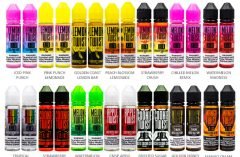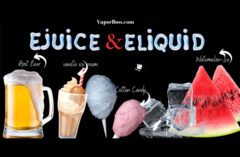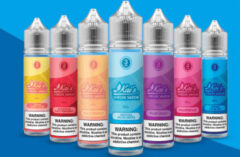Table of Contents [show]

What Is In A Modern Post-2022 Vape Juice?
Vaping, and therefore vape juice, has taken the world by storm for more than a decade. Presenting a modern and enjoyable alternative to traditional smoking, vaping that proved itself to be the best weapon ever devised to combat the ravages of smoking.
While many of us that love vaping seem to care more about the ‘hardware’ side than the ‘software’ side, i.e., vape juice, or e-liquid and e-juice. That said, without a solid and increasing expanded vape juice industry there wouldn’t be anything for all those hardware devices that need e-juice to run.
Within the vibrant landscape of vaping, “Vape Juice” is a key element that brings an explosion of delightful flavors to the forefront. Whether you’re a seasoned vaper or a curious newcomer exploring the world of vape pens and vape flavors in a local vape shop understanding what vape juice consists of is essential to appreciate this ever-evolving experience fully. In this article, we will unlock the mystery behind vape juice and delve into its captivating components, providing you with the knowledge to savor the enticing flavors and sensations of vaping.
Understanding Vape Juice
Vape juice, often referred to as e-liquid, e-juice, or vape liquid, is a fundamental component of modern vape gear or electronic cigarettes. The advent of vaping has transformed nicotine consumption practices, offering an alternative to traditional tobacco smoking that many perceive as less harmful. Central to this phenomenon is the e-liquid, a solution composed of a few key ingredients that, when heated by the vape device, transforms into a vapor that users inhale. Not only does this solution provide the desired nicotine, but it also presents an unprecedented variety of flavors, greatly enhancing the vaping experience.
Key Components of Vape Juice
Components of E-Liquid
E-Liquid typically consists of four primary ingredients: Propylene Glycol (PG), Vegetable Glycerin (VG), nicotine, and flavorings. The proportions of these ingredients can vary significantly, affecting the vaping experience.
Propylene Glycol (PG) is a colorless, odorless compound often used in food processing due to its properties as a preservative and stabilizer. In e-liquids, PG functions as a carrier for nicotine and flavorings, ensuring a consistent and even distribution throughout the liquid. It also provides a ‘throat hit,’ mimicking the sensation of traditional cigarette smoking.
Vegetable Glycerin (VG), derived from plant oils, is thicker and sweeter than PG. It’s responsible for the dense clouds of vapor that many vapers enjoy, and its sweetness can subtly influence the overall flavor of the e-liquid.
Nicotine, the addictive substance found in tobacco, is often included in e-liquids to cater to users who are trying to quit smoking. It’s important to note that the level of nicotine in e-liquids can vary greatly, offering consumers a range of options from high-concentration nicotine e-liquids to completely nicotine-free varieties.
Flavorings, contribute significantly to the overall appeal of vaping. These are typically food-grade additives, the same as those used in cooking and candy making.
The Multitude of E-Liquid Flavors
E-liquids have unlocked an extensive world of flavor profiles far beyond the scope of traditional tobacco products. Indeed, one of the major attractions of vaping is the sheer breadth and diversity of flavors available. Estimates suggest that there are thousands of distinct e-liquid flavors on the market.
Vape Juice flavors range from the conventional to the wildly inventive. Traditional flavors like tobacco and menthol offer familiarity to those transitioning from regular cigarettes to vaping, providing a similar taste experience to what they are used to. Fruit flavors like strawberry, apple, and mango are incredibly popular for their sweetness and ability to refresh the palate.
There’s a burgeoning range of dessert-inspired e-liquids, with flavors mimicking treats such as apple pie, vanilla custard, and chocolate fudge. For the adventurous, there are even cocktail-inspired e-liquids that aim to capture the essence of drinks like mojitos and piña coladas.
Manufacturers continuously experiment and innovate, combining different flavors to create unique blends. As a result, the flavor landscape of e-liquids is ever-evolving, with new and exciting options frequently entering the market.
Customization and Personalization:
One of the most appealing aspects of vape juice is the ability to customize and personalize the vaping experience. Vapers can select their preferred VG/PG ratio and nicotine strength (if desired) and indulge in a wide range of exciting flavors. This level of customization allows users to tailor their vape pen sessions to their specific preferences and cravings.
Modern Vape Juice – A Conclusion:
E-Liquid, with its simple yet flexible composition, is a cornerstone of the vaping industry. Its key components – PG, VG, nicotine, and flavorings – combine to create an experience that can be customized to individual tastes and nicotine needs. The wealth of flavor options, from classic tobacco to exotic fruits and desserts, offers an exciting array of choices, making vaping a highly personalized experience.
As the vaping industry grows and evolves, it’s likely we’ll see even more creativity and innovation in vape flavors, further expanding the taste horizons of vapers worldwide. However, as with any nicotine product, consumers should use e-liquids responsibly, keeping in mind the potential health risks associated with nicotine use.
Further Reading:
What Is E-liquid And How Many Types Of Vape Flavours Are There?
5 Advantages of 0% Nicotine E-Liquid




